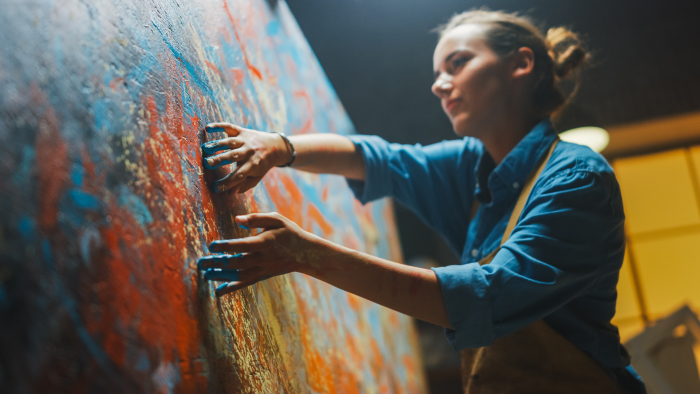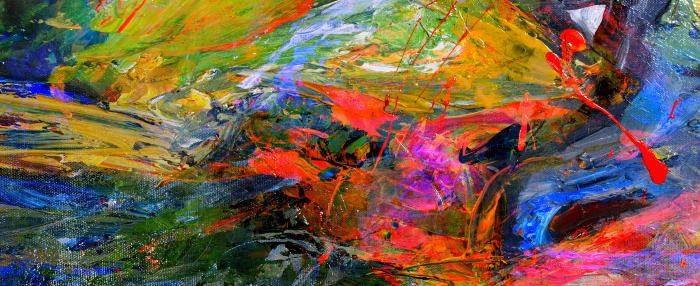
6 ABSTRACT ART TECHNIQUES AND TIPS FOR EVERY NEWBIE ARTIST
In the 21st century, abstract paintings appear effortless and ordinary to everyone, causing people to forget how innovative they were back in the 20th. Such artworks and the artisans who created them caused a remarkable sensation in the world. Like painting representational art, abstract painting also involves expertise and knowledge of art forms, color combinations, and values.
Do you agree that the best kind of exploration is one that has no rules? If so, knowing how to paint abstract art is a terrific place to start your artistic journey. It’s also a surefire way to ensure that your work has compositional strength, visual intrigue, and that it always remains fascinating for you as a rookie artist.
However, learning how to abstract paint isn’t always simple. Aside from taking inspiration from some existing and notable abstract art prints and paintings, you’ll also need to learn some of its techniques for creating beautiful artwork. Fortunately, there are a few pointers below that can assist you in creating your own abstract painting canvas without becoming overwhelmed or too harsh on yourself.

1. Start With Simple Scribbles
Do you prefer to paint a scenario of reality that’s representational or more figurative? Or, do you hardly ever use paint on a surface? If you are, it’s normal if you’re feeling overwhelmed by the prospect of creating an abstract artwork.
Starting with some simple scribbles on paper is an excellent approach to release yourself from the old restrictions of ‘reality.’ If you’re being genuinely natural and carefree, and refuse to drop your pens and pencils, you might be amazed at how sophisticated and intriguing your artistic works could get.
Instead of just thinking about your new ways to create your painting, you should focus on designing your own path to a new way of thinking.
2. Choose The Ideal Painting Spot
If you intend to put your abstract art canvas on a wall, it’s usually preferable to paint it vertically rather than horizontally or flat. However, if you don’t have a canvas stand, it’s completely acceptable if you prop it up against a chair on the flooring. Just don’t forget to prepare rags underneath it as things might get quite messy.
Additionally, ensure that you have a minimum of six feet of physical space behind you. Through this, you can occasionally take a step back from your artwork to get a viewpoint.
3. Slim Down Your Color Scheme
Try to keep things as basic as possible! As a newbie abstract artist, you may find it more convenient to work with a relatively simple color palette. For example, you may try limiting your color palette to blues and whites, with only three to five hues. Then, using a paint palette, you can mix those few to make new colors. Therefore, before creating your abstract art painting, choose a few color schemes and adhere to them.
4. Learn Through Trial And Error
Try a wide range of approaches! Some abstract art artists believe that you only learn to create abstract art by making a lot of mistakes! So, whatever abstract art design you have in mind, you’ll need to experiment with a variety of abstract painting styles.
Most abstract paintings’ visual attractiveness comes from using a variety of approaches to create movement. If you tried something and ended up not liking it, simply paint over it with a different approach.
Painting abstractly is a highly forgiving medium. In the end, you could never wholly ‘ruin’ your abstract painting.
5. Expectations Aren’t A Good Place To Start
Don’t be too harsh on yourself! When things don’t go your way, learning how to create abstract art can be difficult. However, the thrill of creating abstract art on canvas is what makes it so enjoyable!
You may start by imagining the final aesthetic you want. As an example, suppose you intended your painting to resemble a body of water, such as a sea or a pond. In this case, don’t get too worked up over it. Instead, relax. Who knows? You may only be able to ‘find’ the abstract design if you work on it. After a while, you might ‘see’ something recognizable emerging, whether it’s tangible (a scenery) or intangible (feelings).
6. Acquaint Yourself With The Subjective Nature Of Abstract Art
Above all, keep in mind that the appeal of abstract art is purely subjective. What you ‘see’ in it may be very different from what someone else sees. It doesn’t matter if your abstract art painting speaks to others; what matters is that it does speak to you. The definition of beauty lies in the mind of the beholder, after all.
Final Thoughts
Making an abstract painting necessitates a significant amount of effort on your part. After all, there are no specifics from reality that could guide your brushstrokes or compositional choices. It does, however, necessitate the highest level of expressiveness and comprehension of the aforementioned hints.
Additionally, seek all of the aspects that will go into creating your abstract artwork, including those that come from your imagination, expertise, and experience. In the end, abstract art not only allows you to make your own decisions, but it also forces you to do so.


Thanks for the advice . I do sometimes feel like not getting anywhere in achieving what I had in mind. Will keep going as a novice .
It’s important that people know #4 To Learn Through Trial and Error. Abstract Art is not just a bunch of stuff thrown together . It is based to me on feeling the look of what’s going on with what I am hoping to capture. Failing , I have failed many times, but I have been blessed enough to have some paintings that have become a part of my home. Art is one of the most enjoyable things you can do as a hobby or profession. Live,Paint,Love.